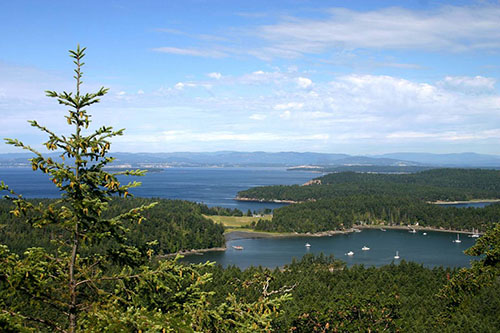- — from Brandon Cadwell for San Juan National Historical Park —
 San Juan Island National Historical Park plans to conduct a prescribed fire on Young Hill between late September and early October 2017, when weather permits. As part of post-burn operations, herbicide will be used in selected areas – less than one acre total – to minimize regeneration of non-native species. The park has concluded that burning and thinning on Young Hill over the past decade has resulted in a reduction of native species composition and an increase of invasive species, specifically grasses.
San Juan Island National Historical Park plans to conduct a prescribed fire on Young Hill between late September and early October 2017, when weather permits. As part of post-burn operations, herbicide will be used in selected areas – less than one acre total – to minimize regeneration of non-native species. The park has concluded that burning and thinning on Young Hill over the past decade has resulted in a reduction of native species composition and an increase of invasive species, specifically grasses.
Fire in the San Juan Islands has historically reduced the spread of shrubs and coniferous trees and cleared the ground for oak seedling regeneration. San Juan Island National Historical Park has been proactively thinning and conducting prescribed burning in the remnant Garry Oak woodland on Young Hill, English Camp. To date the National Park Service (NPS) has recovered approximately 55-acres of habitat through manual mowing of brush thickets, removal of encroaching conifer trees, and low-intensity prescribed burns.
Non-native grasses are often aggressive and out-compete native grasses and wildflowers. They are less palatable to wildlife and diminish the quality of the Garry Oak habitat. The invasive grasses are particularly troublesome due to their early germination and prolific seed production that have enabled them to quickly re-colonize after prescribed fire treatments on Young Hill before native species can recover.
Researchers and public land managers in many areas of the Pacific Northwest are using select herbicides to control non-native grasses in habitats similar to San Juan Island. The park is proceeding with caution and is committed to fostering native ecosystems without compromising the health of this biologically unique area. Areas treated with herbicides will be closed-off and clearly signed to keep people and their animals safe for approximately 10-days.
Fire ecologists will analyze how effective native grasses are able to out-perform non-native grasses in the areas treated with herbicides, versus those without. A secondary objective is to examine burning conditions for the Propertius duskywing butterfly, a sensitive species associated with Garry oak woodlands that have been found in the area. The final report will be posted to the park’s website or mailed to any interested persons. In 2018, the park will begin work on updating its Fire Management Plan and the results of this year’s research will inform alternatives developed for that plan.
More information can be found at parkplanning.nps.gov/YoungHill2017.
**If you are reading theOrcasonian for free, thank your fellow islanders. If you would like to support theOrcasonian CLICK HERE to set your modestly-priced, voluntary subscription. Otherwise, no worries; we’re happy to share with you.**








